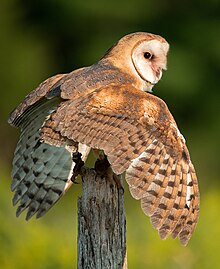Tytonidae
[4] It is believed the modern genus Tyto descended from large nocturnal birds in the West Indies during the Quaternary.
The systematics of this group began with the discovery of Tyto ostologa (now extinct), whose remains were found in north-central Haiti.
[9] Some island subspecies are occasionally treated as distinct species, a move which should await further research into barn owl phylogeography.
According to Murray Bruce in Handbook of Birds of the World Volume 5: Barn-owls to Hummingbirds, "a review of the whole group [is] long overdue".
Barn owls range in colour from the almost beige-and-white nominate subspecies alba, erlangeri, and niveicauda, to the nearly black-and-brown contempta.
Island forms are mostly smaller than mainland ones, and those inhabiting forests have darker plumage and shorter wings than those living in open grasslands.
Of the western barn owl there are 10 subspecies: T. a. alba, T. a. detorta, T. a. erlangeri, T. a. ernesti, T. a. gracilirostris, T. a. guttata, T. a. hypermetra, T. a. poensis, T. a. schmitzi, T. a. thomensis.
Of the American barn owl, there are 10 subspecies: T. f. bargei, T. f. bondi, T. f. contempta, T. f. furcata, T. f. guatemalae, T. f. hellmayri, T. f. niveicauda, T. f. pratincola, T. f. punctatissima, T. f. tuidara.
[18] The main characteristic of the barn owls is the heart-shaped facial disc, formed by stiff feathers which serve to amplify and locate the source of sounds when hunting.
[20] Its range includes all of Europe (except Fennoscandia and Malta), most of Africa apart from the Sahara, the Indian subcontinent, Southeast Asia, Australia, many Pacific Islands, and North-, Central-, and South America.
In the British Isles, the young seem largely to disperse along river corridors, and the distance travelled from their natal site averages about 9 km (5.6 mi).
[22] The barn owl has been successfully introduced into the Hawaiian island of Kauai in an attempt to control rodents; distressingly, it has been found to also feed on native birds.
Its legs and toes are long and slender, which improves its ability to forage among dense foliage or beneath the snow and gives it a wide spread of talons when attacking prey.
[24] It has acute hearing, with ears placed asymmetrically, which improves detection of sound position and distance; the bird does not require sight to hunt.
[25] It may perch on branches, fence posts, or other lookouts to scan its surroundings, and this is the main means of prey location in the oil palm plantations of Malaysia.
[24] On the Cape Verde Islands, geckos are the mainstay of the diet, supplemented by birds such as plovers, godwits, turnstones, weavers, and pratincoles.
[35] On a rocky islet off the coast of California, a clutch of four young were being reared on a diet of Leach's storm petrel (Oceanodroma leucorhoa).
In arid regions, such as parts of Australia, breeding may be irregular and may happen in wet periods, with the resultant temporary increase in the populations of small mammals.
The actual dates of egg-laying vary by year and by location, being correlated with the amount of prey-rich foraging habitat around the nest site.
The first primary feather to be shed is a central one, number 6, and it has regrown completely by the time the female resumes hunting.
The secondary and tail feathers are lost and replaced over a similar timescale, again starting while incubation is taking place.
The hot-climate moult may still take place over a long period but is usually concentrated at a particular time of year outside the breeding season.
This is correlated with smaller bursa of Fabricius, glands associated with antibody production, and a lower fecundity of the blood-sucking fly Carnus hemapterus, which attacks nestlings.
Furthermore, the barn owl is likely the most numerous of all raptors, with the IUCN Red List assessor estimating a population possibly as large as nearly 10 million individuals.
[10][42] In Canada, barn owls are no longer common and are most likely to be found in coastal British Columbia south of Vancouver,[60] having become extremely rare in a previous habitat, southern Ontario.
[62] This is primarily because of disappearing grasslands where the bird hunted in the past, but according to a study, also because of "harsh winters, predation, road mortality and use of rodenticides".
Due to the assignment to this subspecies of birds common in mainland Spain, the western Canary Islands population is not classified as threatened.
[70] Conservationists encourage farmers and landowners to install nest boxes by pointing out that the resultant increased barn owl population would provide natural rodent control.
[73][74] These owls do not "hoot", instead emitting raspy screeches and hissing noises, and their white face and underbelly feathers, visible as they fly overhead, make them look "ghostly".
In some South African cultures, these owls are used in muthi, a form of traditional medicine, and are believed to give special powers when consumed.







